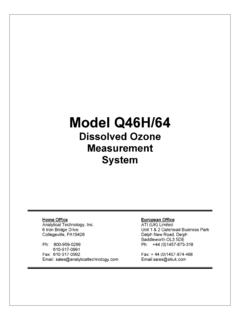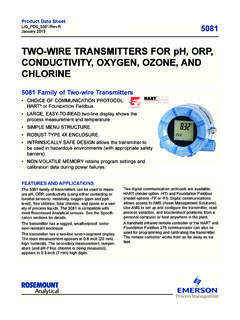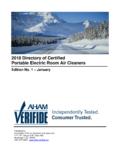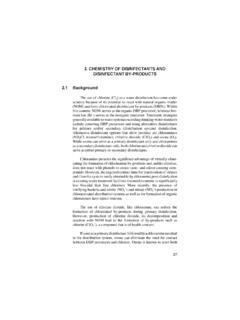Transcription of ORP Millivolts - Ozone Generators
1 Aquarius Technologies Pty. - 2002 AT_TB_018 Rev 3 Page 1 of 4 ORP Millivolts -The Sensor for measurement of DisinfectionOxidising biocides such as gas or liquid Chlo-rine, Bromine and Ozone have been used for manyyears in potable water and swimming pools for recent years both liquid bromine for-mulations and BCDMH bromine release biocides haveproved to be very effective in control of bacterial lev-els in cooling water systems and in swimming is a very strong oxidising agent and itsuse in both cooling water systems and swimming poolsis gaining - oxidation reduction potential sensors,when coupled with differential inputs, high gain ampli-fiers and ground reference probes and microproc-essor control circuitry, can provide for automatic con-trol with dosage proportional to the disinfection sensors can also provide for both highand low alarm signals, plus, via a computer, and allthe data can be logged, to provide a hard copy recordof the ORP millivolt levels maintained and verificationof the levels of disinfection , control tests based on the DPD testmethod.
2 And expressed in ppm Free Chlorine has beenthe widely accepted method of control of the true performance criteria for disinfectionlevel is Total Bacteria Counts or Heterotrophic ORP sensor does NOT indicate actual FreeChlorine levels. Only when the pH is maintained at aconstant value, see figure 1 below, does the straightline relationship between ORP and Free Chlorine paper presented to the American CoolingTower Institute - TP92-08 1 showed a relationship be-tween ORP Millivolts and Free Chlorine which variedwhen pH values changed between and the majority of cooling water systems, and occa-sionally inadequately controlled swimming pools havepH values in the region of to.
3 We decided toinvestigate the ORP and free Chlorine relationship atthese higher pH investigation was carried out on arecirculating water system fitted with carefully cali-brated Aquarius, pH & ORP control systems, with datalogging using Labtech se-ries of measurements for ORP Millivolts and Free Chlo-rine residual were performed using a Hanna Model95711 photometer, which utilises the DPD test methodand is capable of reading from to ppm. asFree Free Chlorine levelswere gradually increased and the corresponding milli-volts were measured after steady state conditions,whilst the pH values were maintained constant at pHvalues of , and results are shown graphically on Figure 2below, as the pH value is increased, higher levels ofFree Chlorine are required to maintain the same ORPmillivolt level, or at constant Free Chlorine levels theORP millivolt output is reduced as pH values increase.
4 Note the straight line drawn on the graph aboveat 600 Millivolts ,- at pH , the Free chlorine reading is ppm,- at pH , the Free chlorine reading is ppm,- at pH , the Free chlorine reading is 500 600 700 800 900 ORP 1 10 ppm Free Chlorine as per DPD testat pH Millivolts versus Free Chlorineat pH 300 400 500 600 700 800 900 ORP 1 10 ppm Free Chlorine as per DPD testpH Millivolts versus Free Chlorineat pH values of , , SystemQualityEndorsedCompanyISO 9001 Lic. No. 5403 Aquarius Technical Bulletin - No. 18 Advanvced Technology For The New Millennium AQUARIUS TECHNOLOGIES PTY LTD 94010 393 254 BOX 71, COOPERS PLAINS, Q.
5 4108 UNIT 1, 23 RICHLAND AVENUE, COOPERS PLAINS, Q. 4108 TELEPHONE: (07) 3274 4750 FAX: (07) 3274 4736 Aquarius Technologies Pty. - 2002 AT_TB_018 Rev 3 Page 2 of 4 The chemistry of chlorine solutions in waterhas reactions as follows + H20 = HOCl + NaOHHOCl <----> H+ + products react similarly to giveHOBr <-----> H+ + OBr-The DPD test for Free Chlorine measures thetotal reaction ( HOCl <---> H+ + OCl- ) and containsbuffers 2 to maintain the sample at pH - , but theamount of HOCl which is present is pH dependant vary-ing from 91% to 3% over the pH range - , andas shown in the following table 3 Free Chlorine Free Bromine pH Value %HOCl %OCl - %HOBr % 91 9 99 75 25 98 49 51 93 23 77 81 9 91 58 3 97 30 70 Technical literature shows that the HOCl & HOBrions are the much stronger oxidising agents than arethe OCl- or OBr.
6 Ions and that the HOCl & HOBr areboth about 100 to 300 times more efficient in microbio-logical killing power or disinfection than are the OCl- orOBr, is well known in cooling water treatment ppm Free Chlorine in a cooling system at pH maintain a Total Plate Count of 102 - 103 ColonyForming Units/ml (cfu/ml) and that the same ppmin a system at pH will reduce TPC s to 105 -106 based biocides have been used exten-sively in recent years because at the higher pH valuesin cooling water systems much more HOBr is avail-able at these pH values to effectively kill pH only 9% of the chlorine added is avail-able as HOCl, whereas 58% of the bromine is avail-able as HOBr, so we can assume a much greater micro-biological kill from bromine products at pH.
7 On aconcentration is amply supported bythe many tests carried out on cooling water sam-plesIn the treatment of swimming pools the pH isnormally maintained between to balance thewater s corrosivety and scaling pHrange also greatly assists the bacteria kill or disinfec-tion rates as 50% of the chlorine added is available asHOCl ion at this early as the 1960 s, German and Swedishscientists 4,5 had shown that the inactivation or killrate of bacteria by oxidising agents was accuratelypredicted by ORP millivolt level and that it was notpossible to formulate a relationship between bac-terial kill rate and concentration of Free that ORP Millivolts , regardless of water qual-ity, accurately predicts inactivation or kill rates we return to Figure 2 and observe the line forconstant ORP Millivolts at 600 mV.
8 And then calculatethe amount of HOCl ion that would be available at thedifferent pH values we can draw a remarkable conclu-sion, ORP at 600 mV. = ppm HOCl at the 3different pH values, pH ppm ppm Millivolts Value Free Chlorine HOCl ORP we draw a similar line at 700 mV. and calcu-late the HOCl ion amount, the results are as follows pH ppm ppm Millivolts Value Free Chlorine HOCl ORP It can be concluded that the ORP probe output isproportional to the concentration of HOCl on above data we plotted ORP mV. againstthe calculated amount of HOCl present and similarlyfor ORP mV.
9 Versus HOBr. The results, see below,show good straight line relationshipsFrom the above data it is clear that the ORP sensor isresponding to the much more powerful oxidising agents,From published technical literature, graphs have alsobeen plotted of the Total Plate Count, poliovirusdeactivation versus ORP mV. and from this data andwater treatment experience we should be able to plug in an ORP millivolt Set Point control valueof 450 - 500 mV. on most cooling towers, and ex-pect to maintain 102 -103 and be able to disre-gard both pH value and pH chlorine levels and ORP Millivolts read-ings from a cooling water system, obtained over alengthy period were plotted against Total Plate Countsto give the graph below.
10 6300 400 500 600 700 800 900 ORP 1 10 ppm of HOClppm of HOBrORP ControlMillivolts V. HOCl at 25 CAquarius Technical Bulletin - No. 18 - ORP Millivolt Sensor Aquarius Technologies Pty. - 2002 AT_TB_018 Rev 3 Page 3 of 4 The chlorine demand of a cooling system varies withmany things but essentially will vary with load, or theevaporation rate of the cooling to the small volumes of water in most cool-ing systems there is no buffer for chlorine demand anddosage must be proportional to the varying demand iftight control of chlorine (or bromine) is to be pools usually have large volumes andsufficient buffer volume for pH control, but the chlorinedemand is essentially equal to the bather load.





